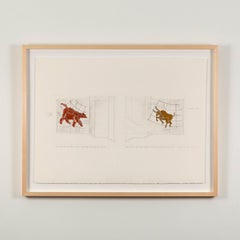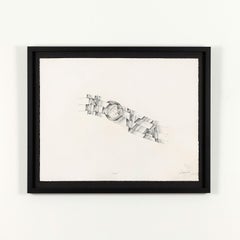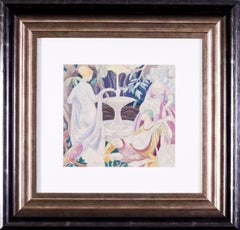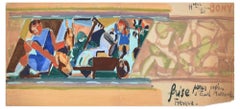General Idea Figurative Drawings and Watercolors
General Idea was commissioned by the Toronto Stock Exchange to install a work/mural. Shortly after the TSX published two prints, a lithograph poster and a limited edition print. However, most of the edition was destroyed/thrown away, when they moved from the trading floor at the TD Centre to their offices. As a result, the work has almost achieved mythological status amongst General Idea collectors.
to
2
Overall Width
to
Overall Height
to
2
1
1
1
1
1
1
2
1
1
1
1
31
888
324
192
178
2
Artist: General Idea
East Wall
By General Idea
Located in Toronto, Ontario
In 1967, General Idea was founded in Toronto by AA Bronson (b. 1946), Felix Partz (1945-1994), and Jorge Zontal (1944-1994). Over 25 years, they made a significant contribution to po...
Category
1980s Post-Modern General Idea Figurative Drawings and Watercolors
Materials
Gold Leaf
Nova
By General Idea
Located in Toronto, Ontario
In 1967, General Idea was founded in Toronto by AA Bronson (b. 1946), Felix Partz (1945-1994), and Jorge Zontal (1944-1994). Over 25 years, they made a significant contribution to po...
Category
1970s Conceptual General Idea Figurative Drawings and Watercolors
Materials
Graphite
$7,000
Related Items
A musical idyll; and The masked ball (a pair)
Located in Petworth, West Sussex
Walpole Champneys (British, 1879 – 1961)
A musical idyll; and The masked ball (a pair)
The former signed and dated ‘W.CHAMPNEYS /.28.’
Pencil and watercolour and gouache on paper
The...
Category
Early 20th Century Art Deco General Idea Figurative Drawings and Watercolors
Materials
Paper, Watercolor, Gouache, Pencil
Sketch for Frescoed Frieze - Pencil and Gouache by Paul Bony - 1932
By Paul Henry Bony
Located in Roma, IT
Sketch for Frescoed Frieze is an interesting preparatory study realized by the artist Paul Bony, a famous French painter active in the last century. The artwork is in good state of p...
Category
1930s Cubist General Idea Figurative Drawings and Watercolors
Materials
Gouache, Pencil
$418
H 7.33 in W 12.21 in D 0.04 in
French School circa 1880, Portrait of a boy holding a book, drawing
Located in Paris, FR
French school circa 1880
Portrait of a boy holding a book
graphite and white gouache on paper
39.5 x 32 cm oval view
in good condition, slightly yellowed with age
In its original ova...
Category
1880s Academic General Idea Figurative Drawings and Watercolors
Materials
Gouache, Pencil
$711
H 15.56 in W 12.6 in
Tippie Comic Strip Original Art - Female Cartoonist
Located in Miami, FL
An early example from pioneering Female Cartoonist/ Illustrator Edwina Dumm, who draws a comic strip from her long-running cartoon series Tippie which lasted for almost five decades. Signed and dated Edwina, 9-25, matted but unframed.
Frances Edwina Dumm (1893 – April 28, 1990) was a writer-artist who drew the comic strip Cap Stubbs and Tippie for nearly five decades; she is also notable as America's first full-time female editorial cartoonist. She used her middle name for the signature on her comic strip, signed simply Edwina.
Biography
One of the earliest female syndicated cartoonists, Dumm was born in Upper Sandusky, Ohio, and lived in Marion and Washington Courthouse, Ohio throughout her youth before the family settled down in Columbus.[1] Her mother was Anna Gilmore Dennis, and her father, Frank Edwin Dumm, was an actor-playwright turned newspaperman. Dumm's paternal grandfather, Robert D. Dumm, owned a newspaper in Upper Sandusky which Frank Dumm later inherited. Her brother, Robert Dennis Dumm, was a reporter for the Columbus Dispatch, and art editor for Cole Publishing Company's Farm & Fireside magazine.
In 1911, she graduated from Central High School in Columbus, Ohio, and then took the Cleveland-based Landon School of Illustration and Cartooning correspondence course. Her name was later featured in Landon's advertisements. While enrolled in the correspondence course, she also took a business course and worked as a stenographer at the Columbus Board of Education.
In 1915, Dumm was hired by the short-lived Republican newspaper, the Columbus Monitor, to be a full-time cartoonist.[2] Her first cartoon was published on August 7, 1915, in the debut issue of the paper. During her years at the Monitor she provided a variety of features including a comic strip called The Meanderings of Minnie about a young tomboy girl and her dog, Lillie Jane, and a full-page editorial cartoon feature, Spot-Light Sketches[3]. She drew editorial cartoons for the Monitor from its first edition (August 7, 1915) until the paper folded (July 1917). In the Monitor, her Spot-Light Sketches was a full-page feature of editorial cartoons, and some of these promoted women's issues. Elisabeth Israels Perry, in the introduction to Alice Sheppard's Cartooning for Suffrage (1994), wrote that artists such as Blanche Ames Ames, Lou Rogers and Edwina Dumm produced:
...a visual rhetoric that helped create a climate more favorable to change in America's gender relations... By the close of the suffrage campaign, women's art reflected the new values of feminism, broadened its targets, and attempted to restate the significance of the movement.[4]
After the Monitor folded, Dumm moved to New York City, where she continued her art studies at the Art Students League. She was hired by the George Matthew Adams Service[5] to create Cap Stubbs and Tippie, a family strip following the lives of a boy Cap, his dog Tippie, their family, and neighbors. Cap's grandmother, Sara Bailey, is prominently featured, and may have been based on Dumm's own grandmother, Sarah Jane Henderson, who lived with their family. The strip was strongly influenced by Mark Twain’s Adventures of Huckleberry Finn, as well as Dumm’s favorite comic, Buster Brown by Richard F. Outcault. Dumm worked very fast; according to comics historian Martin Sheridan, she could pencil a daily strip in an hour.[6]
Her love of dogs is evident in her strips as well as her illustrations for books and magazines, such as Sinbad, her weekly dog page which ran in both Life and the London Tatler. She illustrated Alexander Woollcott's Two Gentlemen and a Lady. For Sonnets from the Pekinese and Other Doggerel (Macmillan, 1936) by Burges Johnson (1877–1963), she illustrated "Losted" and other poems.
From the 1931 through the 1960s, she drew another dog for the newspaper feature Alec the Great, in which she illustrated verses written by her brother, Robert Dennis Dumm. Their collaboration was published as a book in 1946. In the late 1940s, she drew the covers for sheet music by her friend and neighbor, Helen Thomas, who did both music and lyrics. During the 1940s, she also contributed Tippie features to various comic books including All-American Comics and Dell Comics.
In 1950, Dumm, Hilda Terry, and Barbara Shermund...
Category
1920s Conceptual General Idea Figurative Drawings and Watercolors
Materials
Ink, Color Pencil, Graphite
Auguste Mayer (1805-1890) A seascape with a boat, signed drawing
Located in Paris, FR
Auguste Mayer (1803-1890
A seascape with a boat
signed with the initials on the lower left
Pencil and heightenings of white gouache on paper
17.5 x 26 cm...
Category
1860s Romantic General Idea Figurative Drawings and Watercolors
Materials
Gouache, Carbon Pencil
$454
H 6.89 in W 10.24 in
Drawing 14, Series Drawing - Large Format, Charcoal On Paper Panting
By Krzysztof Gliszczyński
Located in Salzburg, AT
The artwork is unframed and will be shipped rolled in a tube
Krzysztof Gliszczyński is Professor for painting on Academy of fine arts Gdansk.
Krzysztof Gliszczyński born in Miastko in 1962. Graduated from the Gdańsk Academy of Fine Arts in 1987 in the studio of Prof. Kazimierz Ostrowski. Between 1995 and 2002 founder and co-manager of Koło Gallery in Gdańsk. lnitiator of the Kazimierz Ostrowski Award, con-ferred by the Union of Polish Artists and Designers (ZPAP), Gdańsk Chapter. Dean of the Painting Faculty of the Gdańsk Academy of Fine Arts in the years 2008-2012. Vice Rector for Development and Cooperation of the Gdańsk Academy of Fine Arts in the years 2012-2016. Obtained a professorship in 2011. Currently head of the Third Painting Studio of the Painting Faculty of the Gdańsk Academy of Fine Arts. He has taken part in a few dozen exhibitions in Poland and abroad. He has received countless prizes and awards for his artistic work. He is active in the field of painting, drawing, objects, and video.
Artist Statement
In the 1990s I started collecting flakes of paint – leftovers from my work. I would put fresh ones in wooden formworks, dried ones in glass containers. They constituted layers of investigations into the field of painting, enclosed in dated and numbered cuboids measuring 47 × 10.5 × 10.5 cm. I called those objects Urns. In 2016, I displayed them at an exhibition, moulding a single object out of all the Urns. The Urns inspired me to redefine the status of my work as a painter. In order to do it, I performed a daunting task of placing the layers of paint not in an urn, but on a canvas, pressing each fresh bit of paint with my thumb. In the cycle of paintings Autoportret a’retour, the matter was transferred from painting to painting, expanding the area of each consecutive one. Together, the bits, the residua of paint, kept alive the memory of the previous works. It was a stage of the atomization of the painting matter and its alienation from the traditional concepts and aesthetic relations. Thus, the cycle of synergic paintings was created, as I called them, guided by the feeling evoked in me by the mutually intensifying flakes of paint. The final aesthetic result of the refining of the digested matter was a consequence of the automatism of the process of layering, thumb-pressing, and scraping off again. Just like in an archaeological excavation, attempts are made to unite and retrieve that which has been lost. This avant-garde concept consists in transferring into the area of painting of matter, virtually degraded and not belonging to the realm of art. And yet the matter re-enters it, acquiring a new meaning. The matter I created, building up like lava, became my new technique. I called it perpetuum pictura – self-perpetuated painting. Alchemical concepts allowed me to identify the process inherent in the emerging matter, to give it direction and meaning. In a way, I created matter which was introducing me into the pre-symbolic world – a world before form, unnamed. From this painterly magma, ideas sprung up, old theories of colour and the convoluted problem of squaring the circle manifested themselves again. Just like Harriot’s crystal refracted light in 1605, I tried to break up colour in the painting Iosis. Paintings were becoming symptoms, like in the work Pulp fiction, which at that time was a gesture of total fragmentation of matter and of transcending its boundaries, my dialogue with the works of Jackson Pollock and the freedom brought by his art. The painting Geometrica de physiologiam pictura contains a diagram in which I enter four colours that constitute an introduction to protopsychology, alchemical transmutation, and the ancient theory of colour. It this work I managed to present the identification of the essence of human physiology with art. But the essential aspect of my considerations in my most recent paintings is the analysis of abstraction, the study of its significance for the contemporary language of art and the search for the possibilities of creating a new message. For me, abstraction is not an end in itself, catering to the largely predicable expectations of the viewers. To study the boundary between visibility and invisibility, like in the work Unsichtbar, is to ask about the status of the possibilities of the language of abstraction. The moment of fluidity which I am able to attain results from the matter – matter...
Category
Early 2000s Conceptual General Idea Figurative Drawings and Watercolors
Materials
Paper, Charcoal
$2,955
H 78.75 in W 59.06 in
Caricature. "A bon chat bon rat" lithograph on paper, 30x22 cm
By Honoré Daumier
Located in Riga, LV
Honore-Victor Daumier (1808–1879) - Caricature. "A bon chat bon rat" lithograph on paper, 30x22 cm
Category
1840s Conceptual General Idea Figurative Drawings and Watercolors
Materials
Paper, Lithograph
$468 Sale Price
20% Off
H 11.82 in W 8.67 in D 0.04 in
Fool's Paradise Movie Costume Sketch Cecil B. DeMille - Classic Hollywood
Located in Miami, FL
Natacha Rambova imaginatively conceives and sketches a costume for Cecil B. DeMille's 1921 movie Fool's Paradise: Paramount. Rendered in Gouache, watercolor, pencil, and metallic s...
Category
1920s Symbolist General Idea Figurative Drawings and Watercolors
Materials
Silver, Bronze
$12,000
H 13.5 in W 9.75 in
Drawing 13, Series Drawing - Large Format, Charcoal On Paper Panting
By Krzysztof Gliszczyński
Located in Salzburg, AT
The artwork is unframed and will be shipped rolled in a tube
Krzysztof Gliszczyński is Professor for painting on Academy of fine arts Gdansk. ...
Category
Early 2000s Conceptual General Idea Figurative Drawings and Watercolors
Materials
Paper, Charcoal
$2,989
H 78.75 in W 59.06 in
The imperceptible beating of the heart Hélène Duclos Contemporary art drawing
By Hélène Duclos
Located in Paris, FR
Gouache and color pencil on paper
Unique work
Hand-signed by the artist
The red necklace of the naked Queens
“My artistic research has expanded over the years, crossing paths alre...
Category
2010s Contemporary General Idea Figurative Drawings and Watercolors
Materials
Paper, Gouache, Color Pencil
$4,664
H 23.63 in W 31.5 in
Vintage Parisian Theater Sketch - Bonnet Beauty
Located in Houston, TX
Darling gouache and pencil sketch of a feminine stage costume complete with matching bonnet for a Paris theater by Willie & Co., circa 1930.
Original artwork on paper displayed on a...
Category
1920s General Idea Figurative Drawings and Watercolors
Materials
Gouache, Paper, Pencil
'International Bar', French School
Located in London, GB
'International Bar, pencil, ink and gouache on card stock by an unnamed artist of the French School (20th Century). This appears to be a fantastical port visit of the artist's imagination. It is very lively in colour and in subject. The artwork was discovered in Paris along with several others of the same character, most likely by the same person. It depicts the entryway of a brightly lit Asian bar...
Category
20th Century General Idea Figurative Drawings and Watercolors
Materials
Ink, Gouache, Pencil
General Idea figurative drawings and watercolors for sale on 1stDibs.
Find a wide variety of authentic General Idea figurative drawings and watercolors available for sale on 1stDibs. You can also browse by medium to find art by General Idea in gold leaf, gold, gouache and more. Not every interior allows for large General Idea figurative drawings and watercolors, so small editions measuring 23 inches across are available. General Idea figurative drawings and watercolors prices can differ depending upon medium, time period and other attributes. On 1stDibs, the price for these items starts at $7,500 and tops out at $7,500, while the average work can sell for $7,500.



